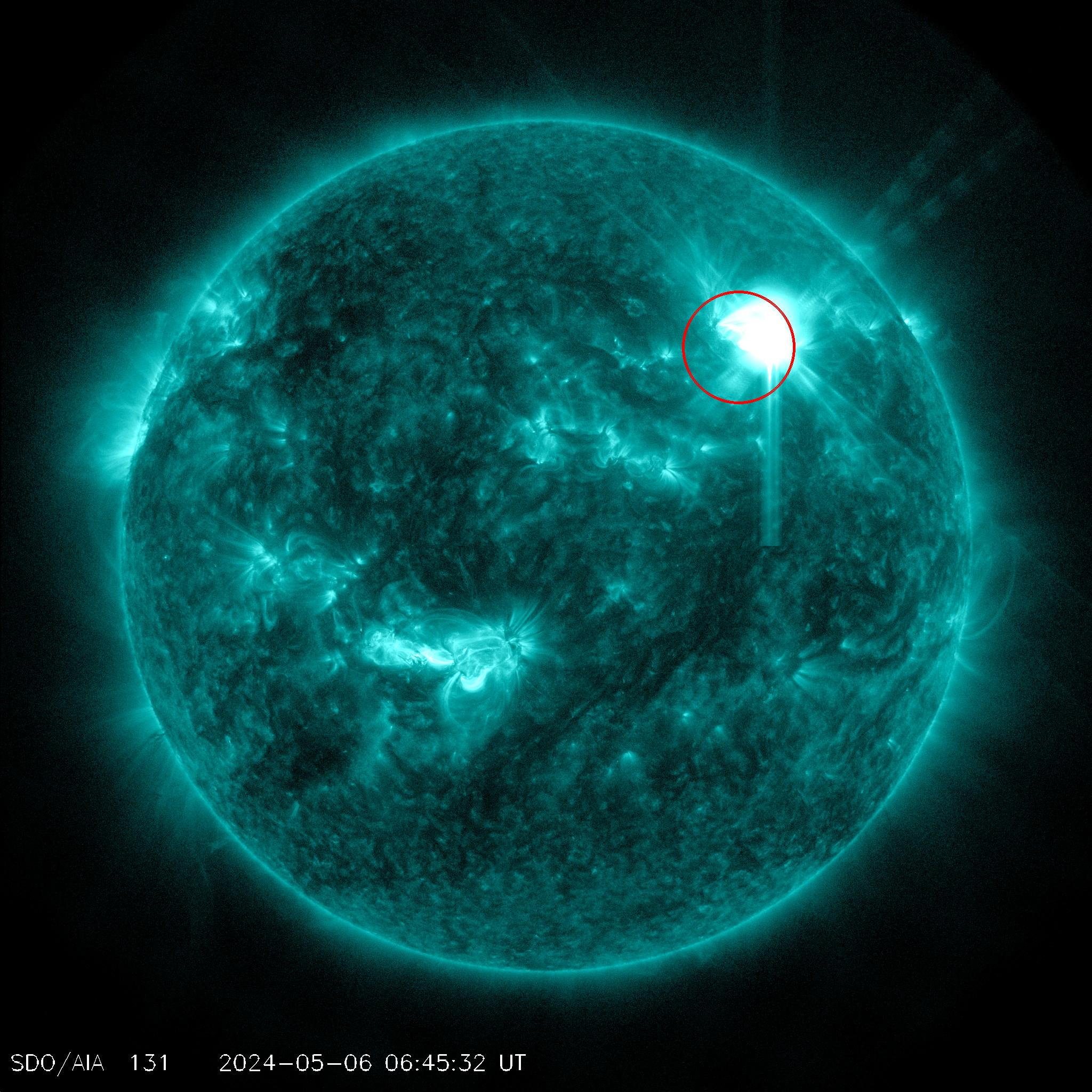Weather experts warn of potential disruptions to power grids, communications as sun’s outburst continues in coming days.

https://www.aljazeera.com/news/2024/5/11/awe-and-alarm-as-extreme-solar-storm-hits-earth
May 11th 2024
The most powerful solar storm in more than 20 years has struck Earth’s atmosphere, triggering warnings over the potential disruption to power grids and satellite communications while also producing spectacular celestial light shows in some parts of the world.
The US National Oceanic and Atmospheric Administration (NOAA), which issued a rare solar storm warning, said the solar outburst reached Earth at about 16:00 GMT on Friday, hours sooner than anticipated.
The first of several coronal mass ejections (CMEs), described as the expulsions of plasma and magnetic fields from the sun, was later upgraded by the NOAA to an “extreme” geomagnetic storm.
It was the first solar storm occurrence since the Halloween storms of October 2003, which caused blackouts in Sweden and damaged power infrastructure in South Africa.
More solar expulsions are expected in the coming days, and possibly into next week, according to the NOAA.
The United States agency alerted operators of power plants and spacecraft in orbit to take precautions.
Fluctuating magnetic fields associated with geomagnetic storms induce currents in long wires, including power lines, which can potentially cause blackouts. Long pipelines can also become electrified, leading to engineering problems.
Spacecraft are at risk from high doses of radiation, although the atmosphere prevents this from reaching Earth.
Following one particularly strong peak, the NOAA’s Space Weather Prediction Center said users of high-frequency radio signals “may experience temporary degradation or complete loss of signal on much of the sunlit side of Earth”.
Unlike solar flares, which travel at the speed of light and reach Earth in about eight minutes, CMEs travel at a steadier pace, with officials putting the current average at 800km (500 miles) per second.
They said that the CMEs emanated from a massive sunspot cluster that is 17 times wider than Earth.
Even pigeons and other species that have internal biological compasses could be affected. Pigeon handlers have noted a reduction in birds coming home during geomagnetic storms, according to US space agency NASA’s Jet Propulsion Laboratory.
The most powerful geomagnetic storm in recorded history, known as the Carrington Event after British astronomer Richard Carrington, occurred in September 1859.
‘Gift from space’
Social media lit up with people posting pictures of auroras from northern Europe and Australasia.
“We’ve just woken the kids to go watch the Northern Lights in the back garden! Clearly visible with the naked eye,” Iain Mansfield in Hertford, England, told the AFP news agency.
That sense of wonder was shared in Australia’s island state of Tasmania.
“Absolutely biblical skies in Tasmania at 4am this morning,” photographer Sean O’Riordan posted on X alongside a photo.
The storm could also produce northern lights as far south in the United States as Alabama and across northern California, according to the NOAA.
But it was hard to predict and experts stressed it would not be the dramatic curtains of colour normally associated with the Northern Lights, but more like splashes of greenish hues.
“That’s really the gift from space weather – the aurora,” Rob Steenburgh, a scientist with the Space Weather Prediction Center, told The Associated Press news agency.

Source: Al Jazeera
Traduzione in italiano
STUPORE E ALLARME MENTRE LA TEMPESTA SOLARE “ESTREMA” COLPISCE LA TERRA
Gli esperti meteorologici avvertono di potenziali interruzioni delle reti elettriche e delle comunicazioni mentre lo scoppio del sole continuerà nei prossimi giorni.

11 Maggio 2024
La tempesta solare più potente degli ultimi 20 anni ha colpito l’atmosfera terrestre, innescando allarmi sulla potenziale interruzione delle reti elettriche e delle comunicazioni satellitari e producendo anche spettacolari spettacoli di luci celesti in alcune parti del mondo.
La National Oceanic and Atmospheric Administration (NOAA) degli Stati Uniti, che ha emesso un raro avviso di tempesta solare, ha affermato che l’esplosione solare ha raggiunto la Terra intorno alle 16:00 GMT di venerdì, ore prima del previsto.
La prima di numerose espulsioni di massa coronale (CME), descritte come l’espulsione di plasma e campi magnetici dal sole, è stata successivamente trasformata dalla NOAA in una tempesta geomagnetica “estrema”.
È stata la prima tempesta solare che si è verificata dopo la tempesta di Halloween dell’ottobre 2003, che ha causato blackout in Svezia e danneggiato le infrastrutture elettriche in Sud Africa.
Secondo la NOAA, sono previste ulteriori espulsioni solari nei prossimi giorni, e forse anche nella prossima settimana.
L’agenzia degli Stati Uniti ha allertato gli operatori delle centrali elettriche e dei veicoli spaziali in orbita affinché prendano precauzioni.
I campi magnetici fluttuanti associati alle tempeste geomagnetiche inducono correnti nei cavi lunghi, comprese le linee elettriche, che possono potenzialmente causare blackout. Anche le condutture lunghe possono diventare elettrificate, causando problemi tecnici.
I veicoli spaziali sono esposti al rischio di alte dosi di radiazioni, sebbene l’atmosfera impedisca a queste di raggiungere la Terra.
A seguito di un picco particolarmente forte, il Centro di previsione meteorologica spaziale della NOAA ha affermato che gli utenti di segnali radio ad alta frequenza “potrebbero sperimentare un degrado temporaneo o una perdita completa del segnale su gran parte del lato illuminato dal sole della Terra”.
A differenza delle eruzioni solari, che viaggiano alla velocità della luce e raggiungono la Terra in circa otto minuti, le CME viaggiano a un ritmo più costante, con la media attuale che i funzionari stimano a 800 km (500 miglia) al secondo.
Hanno affermato che le CME provenivano da un enorme ammasso di macchie solari che è 17 volte più ampio della Terra.
Anche i piccioni e altre specie dotate di bussola biologica interna potrebbero esserne colpiti. Secondo il Jet Propulsion Laboratory dell’agenzia spaziale statunitense NASA, gli allevatori di piccioni hanno notato una riduzione del numero di uccelli che tornano a casa durante le tempeste geomagnetiche.
La tempesta geomagnetica più potente della storia, conosciuta come Evento Carrington dal nome dell’astronomo britannico Richard Carrington, si verificò nel settembre 1859.
“Regalo dallo spazio”
I social media si sono accesi di persone che pubblicavano foto di aurore dal Nord Europa e dall’Australasia.
“Abbiamo appena svegliato i bambini per andare a guardare l’aurora boreale nel giardino sul retro! Chiaramente visibile ad occhio nudo”, ha detto all’agenzia di stampa AFP Iain Mansfield di Hertford, in Inghilterra.
Questo senso di meraviglia è stato condiviso nello stato insulare australiano della Tasmania.
“Cieli assolutamente biblici in Tasmania alle 4 di questa mattina”, ha pubblicato il fotografo Sean O’Riordan su X insieme a una foto.
Secondo la NOAA, la tempesta potrebbe anche produrre aurore boreali nell’estremo sud degli Stati Uniti fino all’Alabama e in tutta la California settentrionale.
Ma era difficile da prevedere e gli esperti hanno sottolineato che non si tratterebbe delle drammatiche tende di colore normalmente associate all’aurora boreale, ma piuttosto di macchie di tonalità verdastre.
“Questo è davvero il dono della meteorologia spaziale: l’aurora”, ha detto all’agenzia di stampa Associated Press Rob Steenburgh, uno scienziato dello Space Weather Prediction Center.

Fonte: Al Jazeera








https://x.com/_SpaceWeather_/status/1787052897760391494





























Dott. Alessio Brancaccio, tecnico ambientale Università degli Studi di L’Aquila, membro della Fondazione Michele Scarponi Onlus, ideologo e membro del movimento ambientalista Ultima Generazione A22 Network per contrastare il Riscaldamento Globale indotto artificialmente dalla Geoingegneria Solare SRM




















































